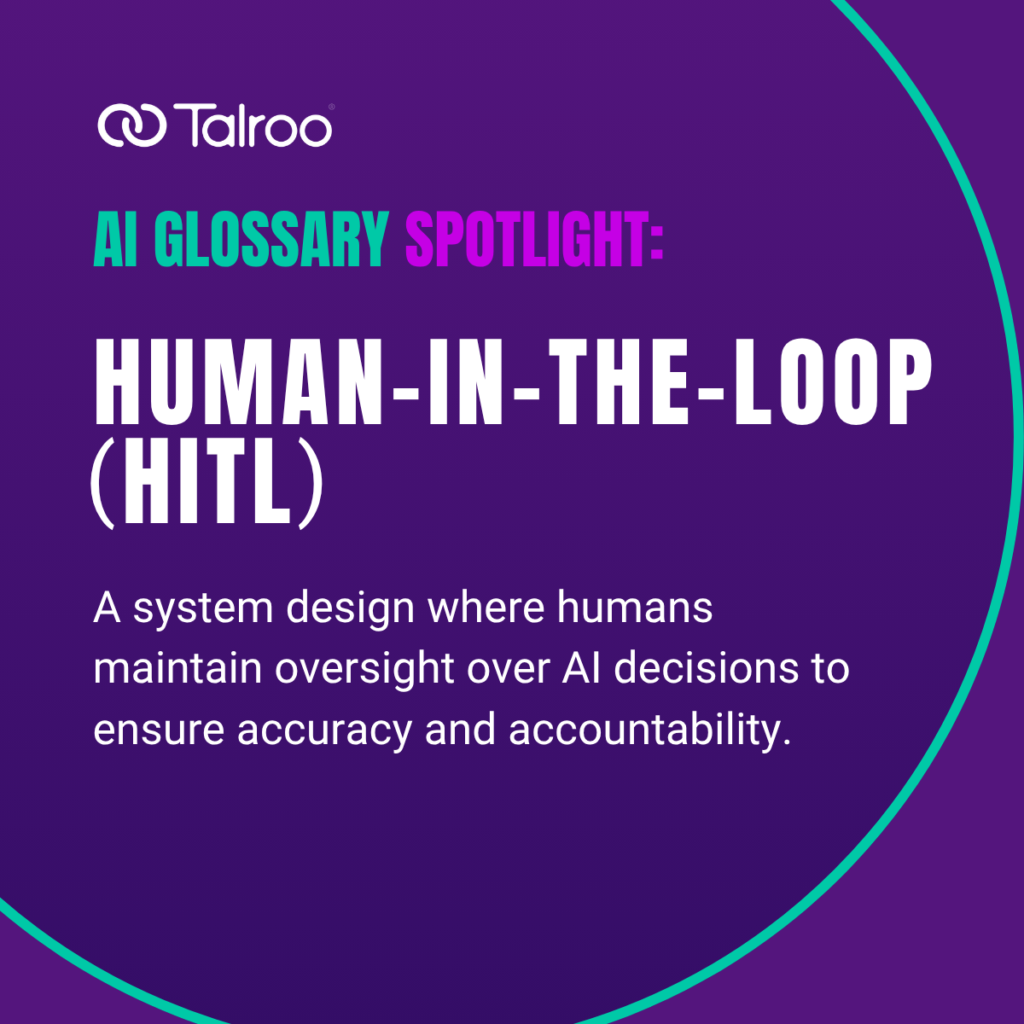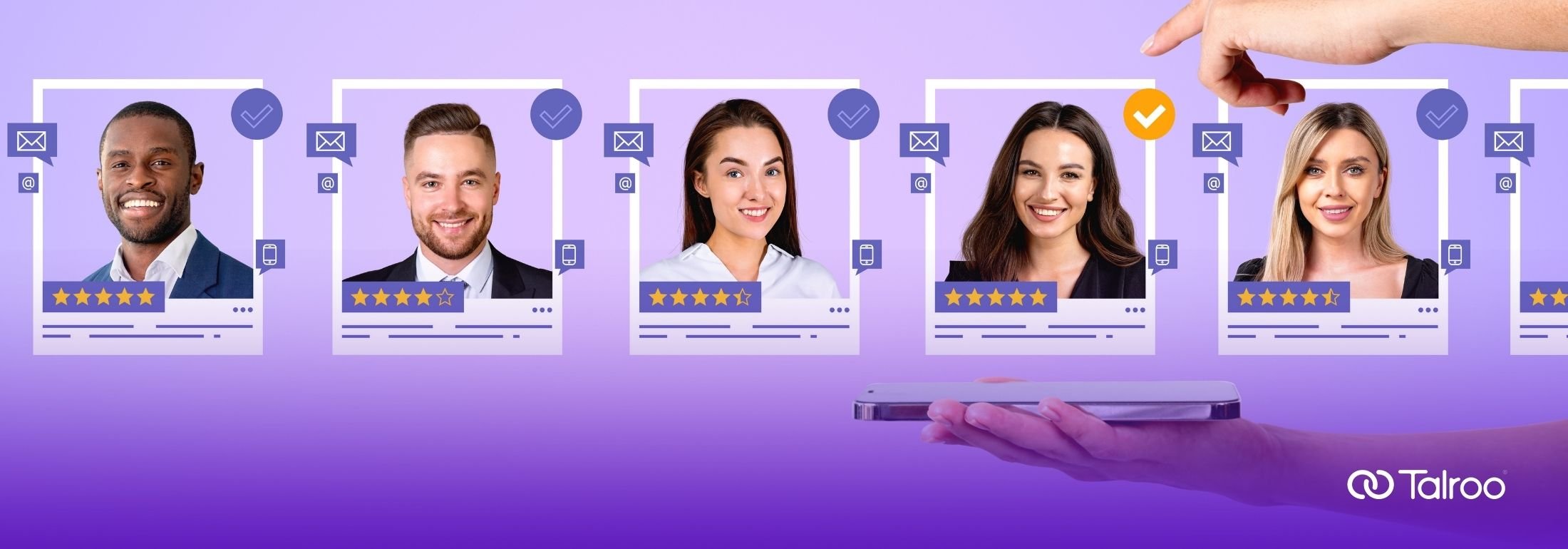
Decoding AI: The Recruiter’s Glossary to Artificial Intelligence in Hiring
AI is transforming the way employers find, evaluate, and hire talent. For talent acquisition teams looking to stay competitive, understanding how artificial intelligence works in the hiring process is no longer optional. But with technical jargon and rapidly evolving tools, navigating the world of AI can feel overwhelming.
Evaluating AI Tools: Reducing Risk and Avoiding Bias
Before we move on to the terminology, there are a few important things to know before you integrate AI into your recruitment process. As AI adoption grows in recruiting, so does scrutiny around fairness and compliance. News headlines have highlighted real risks — such as AI systems that unintentionally screen out qualified candidates based on race, gender, or disability status. In 2023, the EEOC settled its first-ever AI discrimination case involving an AI-powered hiring tool that disproportionately rejected older applicants. Cases like this underscore the importance of vetting AI vendors and tools carefully.
When evaluating AI for hiring, recruiters should ask:
- What data was used to train the model? Biased training data leads to biased outcomes.
- Is the tool regularly audited for fairness and accuracy? Ask vendors for proof of independent audits or validation studies.
- Does the system provide transparency into its decision-making? Look for tools with explainable AI features that allow humans to understand and override automated decisions.
- Is there a HITL (human-in-the-loop)? Fully autonomous systems are riskier. Recruiters should maintain oversight over all final hiring decisions.

- Does the vendor comply with applicable laws? Tools used in the U.S. must align with the EEOC’s AI guidance and emerging state-level regulations.
AI can enhance speed and efficiency, but without careful evaluation, it can also create legal exposure and reputational harm. Responsible use starts with choosing tools that prioritize ethics, transparency, and compliance.
Your AI in Recruiting Cheat Sheet: Glossary Terms
This glossary breaks down the most important AI terms every recruiter and HR professional should know. Whether you are integrating AI into your talent acquisition strategy or evaluating tools to streamline your hiring funnel, this resource will help you make informed and confident decisions.
Each term is defined in plain language with real-world recruiting examples and use cases, so you can see how these technologies apply directly to your work.
1. Artificial Intelligence (AI)
AI refers to software and systems designed to simulate human intelligence such as learning, reasoning, and decision-making.
In hiring: AI can automate repetitive recruiting tasks, analyze large volumes of data, and personalize communication with candidates at scale.
Use case: An AI tool sorts and ranks thousands of applicants based on role requirements, helping recruiters focus on top-qualified candidates.
2. Machine Learning (ML)
A subset of AI that enables systems to learn and improve from data without explicit programming.
In hiring: Machine learning algorithms identify patterns from historical hiring data to predict candidate success or optimize sourcing strategies.
Use case: A recruiting platform uses ML to recommend candidates who are more likely to stay with the company long term based on past hires.
3. Natural Language Processing (NLP)
The branch of AI that enables machines to understand, interpret, and generate human language.
In hiring: NLP powers tools that analyze resumes, generate job descriptions, or conduct candidate communications via chatbots.
Use case: NLP is used to evaluate open-ended candidate responses in screening forms and categorize them for recruiter review.
4. Generative AI
AI systems that create new content such as text, code, or images based on patterns in training data.
In hiring: Generative AI (GenAI) tools can write job descriptions, personalize outreach, and generate interview questions.
Prompt example: “Create a job posting for a bilingual call center representative in Dallas, TX.”
Use case: A recruiter uses generative AI to quickly write inclusive and optimized job descriptions tailored to high-volume roles.
5. AI-Powered Chatbot
A chatbot that uses AI to understand and respond to candidate questions and actions in real time.
In hiring: These chatbots can answer FAQs, guide applicants through the hiring process, and conduct initial screenings.
Use case: A chatbot on a career site answers candidate questions about benefits and schedules interviews without recruiter intervention.
6. Predictive Analytics
The use of historical data and AI to forecast future outcomes.
In hiring: Predictive analytics help recruiters anticipate candidate behavior, such as offer acceptance or likely tenure.
Use case: Talent acquisition teams use predictive analytics to reduce time-to-fill by forecasting the best channels and timing for job postings.
7. Algorithmic Bias
Bias that emerges in AI systems due to biased training data or flawed design.
In hiring: This can lead to unfair treatment or exclusion of candidates based on gender, race, or other protected characteristics.
One recent example: Federal Court Allows Collective Action Lawsuit Over Alleged AI Hiring Bias | Insights | Holland & Knight
Use case: Employers partner with vendors who regularly audit their AI systems to ensure equitable candidate evaluation.
8. AI Hallucination
When an AI tool generates false or misleading information that sounds plausible but is not based on factual data.
In hiring: This can happen when using generative AI for job descriptions or candidate summaries.
Use case: A recruiter double-checks AI-generated candidate profiles to ensure accuracy before passing them to hiring managers.
9. Talent Intelligence
The use of AI to collect and analyze workforce data to make strategic decisions about hiring, reskilling, and workforce planning.
In hiring: Talent intelligence platforms provide insights into labor market trends, competitor hiring patterns, and internal talent pools.
Use case: A TA leader uses talent intelligence to forecast future hiring needs in response to regional market changes.
10. AI Agents
Autonomous tools that can execute tasks and make decisions with minimal human oversight.
In hiring: AI agents can handle entire workflows such as sourcing, screening, and scheduling.
Use case: An AI agent sources passive candidates, sends personalized outreach messages, and books interviews automatically.
11. Resume Parsing
AI-driven technology that extracts structured data from resumes, such as work history, skills, and education.
In hiring: Resume parsers make it easier to sort and compare candidates without manual review.
Use case: A recruiter uses a resume parser to quickly search for applicants with forklift certification across a large talent pool.
12. Intelligent Screening
Automated assessment of resumes and applications using AI to match candidates to job criteria.
In hiring: Intelligent screening tools identify high-potential candidates and flag them for recruiter attention.
Use case: For high-volume hourly roles, AI tools screen for qualifications like shift availability and previous experience.
13. Bias Mitigation
Strategies and practices used to identify and reduce bias in AI systems.
In hiring: This ensures fair and legal use of AI in employment decisions.
Use case: Employers use AI platforms that apply fairness algorithms and anonymize candidate data during screening.
14. Skills-Based Matching
An AI approach that focuses on matching candidates to roles based on specific skills, rather than job titles or degrees.
In hiring: Especially useful for identifying transferable talent or supporting internal mobility.
Use case: A logistics company fills a warehouse supervisor role by identifying a shift lead with matching skills but a different job title.
15. Human-in-the-Loop (HITL)
A system design where humans maintain oversight over AI decisions to ensure accuracy and accountability.
In hiring: Recruiters review AI recommendations and make final decisions, rather than relying entirely on automation.
Use case: An AI tool suggests top candidates for a role, but the recruiter performs a manual screen to ensure cultural fit.
16. Conversational AI
Technology that allows AI to engage in human-like conversations via voice or text.
In hiring: Used for virtual interviews, candidate Q&A, and job application support.
Use case: A conversational AI assistant helps candidates apply for a job via SMS or voice command, reducing drop-off rates.
17. AI-Assisted Interviewing
The use of AI to support interview processes, such as analyzing candidate responses for key skills or behaviors.
In hiring: AI tools can help assess soft skills or score responses for consistency, though human oversight is critical.
Use case: An on-demand video interview platform uses AI to evaluate candidate tone and language against job role requirements.
18. Prompt Engineering
The practice of crafting effective inputs, or prompts, to guide AI tools in generating accurate and relevant outputs.
In hiring: Recruiters use prompt engineering to get the best results from generative AI tools.
Prompt example: “Draft an outreach email to a certified nursing assistant about a full-time evening shift opportunity in Houston.”
19. Semantic Search
AI-powered search that understands the intent and context of a query, rather than relying on exact keyword matches.
In hiring: Helps recruiters find better candidate matches even when terminology differs.
Use case: Searching for “bilingual customer service” returns candidates who listed “fluent in Spanish” and “client-facing experience.”
20. Explainable AI (XAI)
AI systems designed to make their decision-making processes transparent and understandable to users.
In hiring: Crucial for ensuring compliance with employment laws and gaining stakeholder trust.
Use case: An AI platform shows recruiters why a candidate was flagged as high-fit based on location, experience, and availability.
Final Thoughts: Understanding the Language of AI
As AI continues to evolve, so will its role in talent acquisition. Understanding the language of AI is a critical step toward evaluating new technologies, ensuring fair hiring practices, and staying ahead in a competitive talent market.
At Talroo, we help recruiters harness the power of data and automation to connect with the right talent at the right time. Whether you are hiring hourly workers at scale or optimizing your candidate funnel, we are here to support your journey into AI-driven recruiting.




